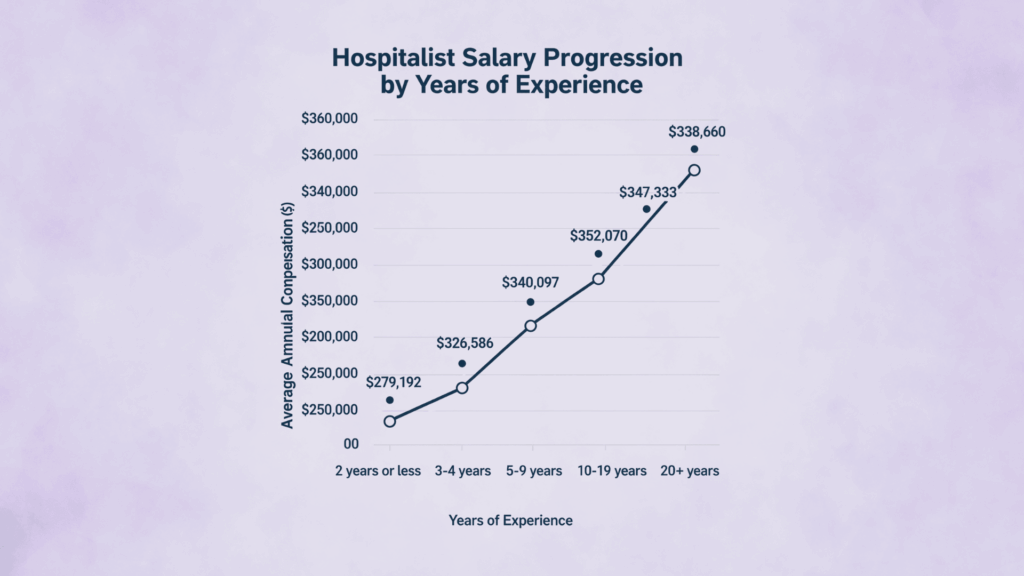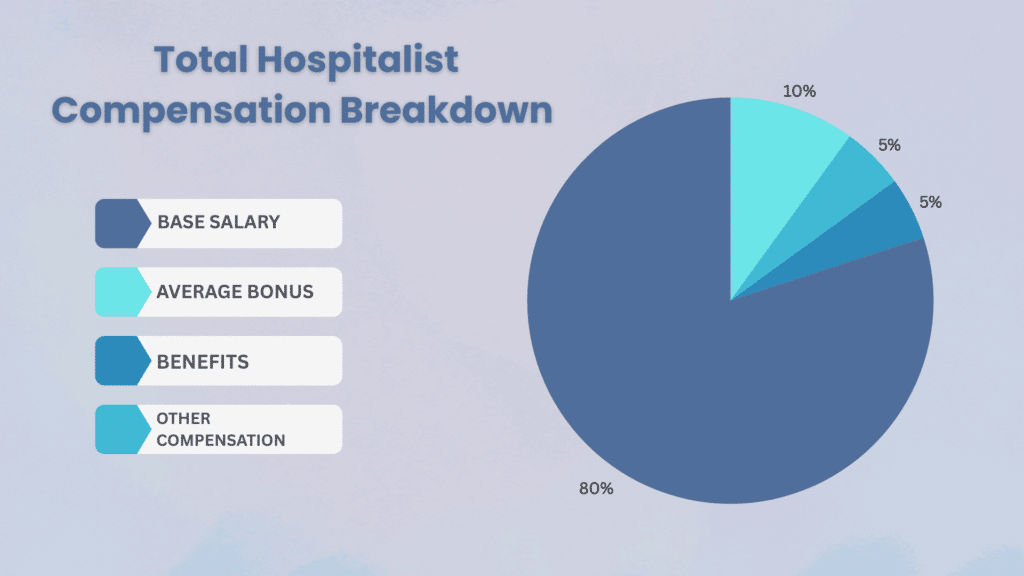The role of hospitalists has grown tremendously over recent decades.
These physicians specialize in caring for hospitalized patients from admission to discharge, coordinating treatment plans and working with specialists.
As hospitals increasingly recognize their value, demand for hospitalists continues to surge nationwide.
Understanding how much hospitals make in different states and the salary trends is crucial for medical professionals considering this specialty.
It also matters for current hospitalists evaluating compensation or administrators planning recruitment.
Regional variations, experience levels, and employer types all significantly impact earning potential.
What is the Average Hospitalist Salary in 2025?
Different salary surveys and industry sources report varying figures for hospitalist compensation, reflecting differences in methodology, sample size, and regional representation.
Average Hospitalist Salary by Source:
- Indeed (based on 1,500+ salaries): $288,136 per year
- Glassdoor: $379,134 annually with a typical pay range between $311,729 (25th percentile) and $471,113 (75th percentile)
- Salary.com: $269,424 with a range from $240,597 to $324,151
- ZipRecruiter: $283,164 per year
- PayScale: $256,619 for 2025, with entry-level (less than 1 year) at $225,832 and early career (1-4 years) at $242,977
Most industry sources agree that the average hospitalist salary falls within the $270,000 to $280,000 range, with significant variations based on location, experience, and employer type.
The discrepancies between sources largely reflect different sampling methods, with some surveys weighted more heavily toward academic institutions or specific regions.
Hospitalists’ Salary Breakdown by Experience Level
The salary range typically falls between $311,700 (25th percentile) and $471,100 (75th percentile) annually, with top earners reporting up to $568,500.
Breaking down by experience level:
|
Factors That Affect a Hospitalist’s Salary
This section covers current salary benchmarks, experience-based progression, and how geography and work settings impact earning potential.
1. USA’s Salary Average
The average salary for hospitalists in the United States ranges from approximately $269,400 to $278,800 annually, though this varies considerably based on multiple factors.
According to recent data, the salary range typically falls between $311,700 (25th percentile) and $471,100 (75th percentile) annually, with top earners reporting up to $568,500.
2. Experience and Education

Experience significantly impacts hospitalist compensation.
- Entry-level hospitalists (less than 1 year): $225,800 – $263,100
- Early career (1-4 years): $242,900 – $264,300
- Mid-career (2-4 years): $270,200
- Senior hospitalists (5-8 years): $281,800
- Experienced professionals (8+ years): $283,900
Board certifications, specializations, and leadership roles further boost earning potential.
3. Geography and Work Setting
Location dramatically affects salaries.
Urban areas offer higher compensation due to case complexity and cost of living, while rural areas provide incentives like loan repayment programs and signing bonuses.
Private practices and for-profit hospitals typically pay more than academic or non-profit institutions, though academic positions offer research opportunities and other benefits.
How Much Do Hospitalists Make in Top-Paying States?
Complete state-by-state salary rankings, regional compensation comparisons, and insights into what drives geographic pay differences nationwide.
1. Highest-Paying States
Washington leads the nation for hospitalist salaries, with the District of Columbia and New York following close behind.
Washington offers salaries that are $37,547 (13.3%) above the national average of $283,164.
The top-paying states for hospitalists include:
- Washington – $320,700+ annually
- District of Columbia – $298,306+ annually
- New York – 9.4% above the national average
- California – $297,175 average
- Massachusetts – $293,214 average
- New Jersey – $292,029 average
- Alaska – $291,651 average
California, New York, and Massachusetts are among the highest-paying states, with average salaries exceeding $260,000, due to factors including the concentration of top-tier hospitals, higher living costs, and robust healthcare infrastructure.
2. Lowest-Paying States
Florida ranks as the lowest-paying state for hospitalist positions, though specific salary figures vary by source and methodology.
The state’s lower compensation levels are often offset by the absence of state income tax and generally lower cost of living compared to high-paying states.
Other states with below-average hospitalist salaries include Alabama ($247,520), Arkansas ($243,398), and several rural states where demand may be lower but lifestyle benefits can be substantial.
3. Regional Pay Analysis
According to recent survey data, hospitalists in the Midwest reported the highest average income at $383,995, about $38,000 (10%) higher than the average pay for all hospitalists who treat adults.
The Northeast reported the lowest compensation at $321,903, creating a $62,000 difference (19%) between the highest and lowest-paying regions.
Regional breakdown:
- Midwest: $383,995 (highest)
- South: Higher bonus potential
- Pacific: Strong salary growth trends
- Northeast: $321,903 (lowest base salary but often with other benefits)
The reasons for these regional differences include cost of living variations, local demand for hospitalists, healthcare funding models, and the presence of medical schools and teaching hospitals.
How Much Do Hospitalists Make by Specialty?
Hospitalists occupy a competitive position within the physician salary spectrum, with compensation generally stronger than that of primary care physicians and many internal medicine practitioners, though below that of highly specialized surgeons.
2025 Hospitalist Salary Comparison:
| Hospitalist Specialty | Annual Salary Range | Premium vs. General Hospitalist |
|---|---|---|
| General Hospitalist | $270,000 – $280,000 | Baseline |
| ObGyn Hospitalist | $372,000 – $400,000 | +33% – 43% |
| Neurohospitalist | $142,000 – $330,000 | Variable (-49% to +18%) |
| Locum Tenens Hospitalist | $320,000 – $330,000 | +15.8% |
| Pediatric Hospitalist | $190,000 – $260,000 | -13% to -7% |
Many hospitalists start their careers in nursing or transition from advanced practice roles.
If you’re a nurse looking to advance into hospital medicine or other specialized positions.
These experienced nurse resume templates, tips, and samples will help you create a resume that stands out in competitive healthcare job markets.
Additional Benefits and Bonuses for Hospitalists
Understanding how performance bonuses, comprehensive benefit packages, and additional compensation significantly boost total hospitalist earnings.
Performance and Retention Bonuses
The average hospitalist receives approximately $43,448 annually from bonuses and incentives, though this can double for some positions. Bonus structures vary significantly by employer type:
- Local hospitalist groups: $79,000 average bonus
- Multispecialty/primary care groups: $60,935 average bonus
- Hospital/hospital corporations: $41,271 average bonus
- National hospital management companies: $38,078 average bonus
- Universities/medical schools: $28,489 average bonus
On average, hospitalists receive annual bonuses ranging from $10,000 to $20,000, which can include performance bonuses, quality of care bonuses, and incentives for meeting specific patient care metrics.
Comprehensive Benefits Packages

Comprehensive benefits packages add significant value beyond base salary, including health insurance, retirement plans, and PTO.
Modern hospitalists particularly value CME funding and generous time-off policies, which have become crucial recruitment factors.
Common benefits include:
- Health, dental, and vision insurance
- Retirement plans with employer matching
- CME allowances and time off (median employer retirement contribution reported at $13,955)
- Professional liability coverage
- Disability and life insurance
- Flexible spending accounts
- Work-life balance initiatives
Specialized Benefits
Many institutions offer additional perks such as health coaching, counseling services, wellness programs, legal insurance, 529 college savings plans, local business discounts, and even pet insurance.
These benefits help organizations attract and retain top hospitalist talent in competitive markets.
Hospitalist Salary Trends in 2025
Examining future job prospects, projected growth in the field, and how compensation trends are expected to evolve in hospital medicine.
Job Growth Projections:
The career outlook for hospitalists remains exceptionally positive. Several factors drive continued demand for these specialized physicians:
- Aging population: As Baby Boomers age, hospital admissions continue to increase.
- Healthcare complexity: Modern inpatient care requires specialized coordination.
- Hospital efficiency: Hospitalists improve patient flow and reduce length of stay.
- Quality metrics: Dedicated inpatient physicians help hospitals meet quality benchmarks.
Changes in Hospitalist Pay Over Time:
Mean hospitalist compensation reached $348,231 in 2024, a 2.6% increase, though 62% didn’t receive individual raises due to multi-year review cycles.
Growing demand from an aging population should support continued salary growth, though at a more moderate pace than post-pandemic increases.
Applying for a hospitalist role? Use these free healthcare resume templates and examples to highlight your skills and stand out.
Conclusion
Hospitalist medicine offers competitive pay averaging $270,000-$280,000 plus $43,000 in bonuses, with extensive benefits and strong job security.
The field continues to expand as hospitals recognize the critical role hospitalists play in improving patient outcomes and operational efficiency.
Regional variations can significantly impact total compensation, making location a key factor in career decisions.
Ready to advance your hospitalist career?
Research regional salary ranges, pursue board certifications, and evaluate comprehensive benefits packages to maximize your earning potential in this rewarding, rapidly growing specialty.
Frequently Asked Questions
Do Hospitalists Work 7 Days On 7 Days Off?
Many hospitalists work 7-on/7-off schedules, though this varies by institution. Other common patterns include block scheduling, 12-hour shifts, or traditional weekly rotations, offering better work-life balance than traditional practice.
How Long Does it Take to Become a Hospitalist?
Becoming a hospitalist typically requires 11-12 years after high school: 4 years undergraduate, 4 years medical school, and 3-4 years residency in internal medicine, family medicine, or pediatrics.
Is a Hospitalist Higher than a Doctor?
No, a hospitalist is a type of doctor specializing in inpatient care. Hospitalists are fully licensed physicians (MDs or DOs) who focus exclusively on hospital-based patient care rather than outpatient medicine.










